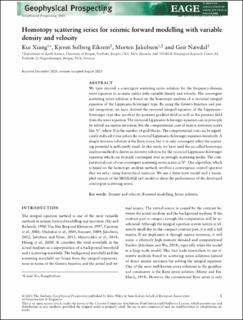Homotopy scattering series for seismic forward modelling with variable density and velocity
Journal article, Peer reviewed
Published version

Åpne
Permanent lenke
https://hdl.handle.net/11250/2825328Utgivelsesdato
2021Metadata
Vis full innførselSamlinger
- Department of Earth Science [1050]
- Registrations from Cristin [9791]
Sammendrag
We have derived a convergent scattering series solution for the frequency-domain wave equation in acoustic media with variable density and velocity. The convergent scattering series solution is based on the homotopy analysis of a vectorial integral equation of the Lippmann–Schwinger type. By using the Green's function and partial integration, we have derived the vectorial integral equation of the Lippmann–Schwinger type that involves the pressure gradient field as well as the pressure field from the wave equation. The vectorial Lippmann–Schwinger equation can in principle be solved via matrix inversion, but the computational cost of matrix inversion scales like 𝑁3 , where 𝑁 is the number of grid blocks. The computational cost can be significantly reduced if one solves the vectorial Lippmann–Schwinger equation iteratively. A simple iterative solution is the Born series, but it is only convergent when the scattering potential is sufficiently small. In this study, we have used the so-called homotopy analysis method to derive an iterative solution for the vectorial Lippmann–Schwinger equation which can be made convergent even in strongly scattering media. The computational cost of our convergent scattering series scales as 𝑁2 . Our algorithm, which is based on the homotopy analysis method, involves a convergence control operator that we select using hierarchical matrices. We use a three-layer model and a resampled version of the SEG/EAGE salt model to show the performance of the developed convergent scattering series.
